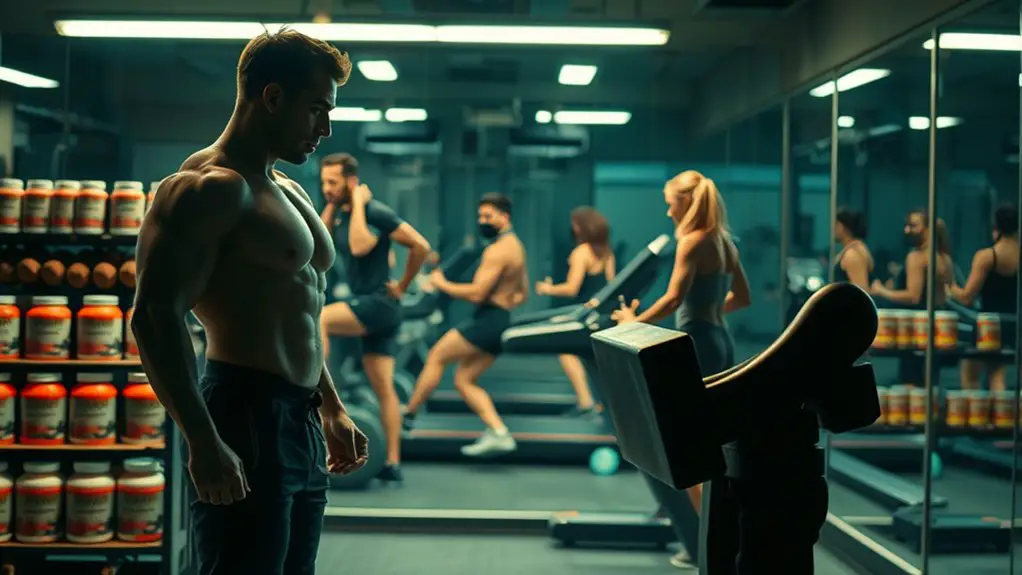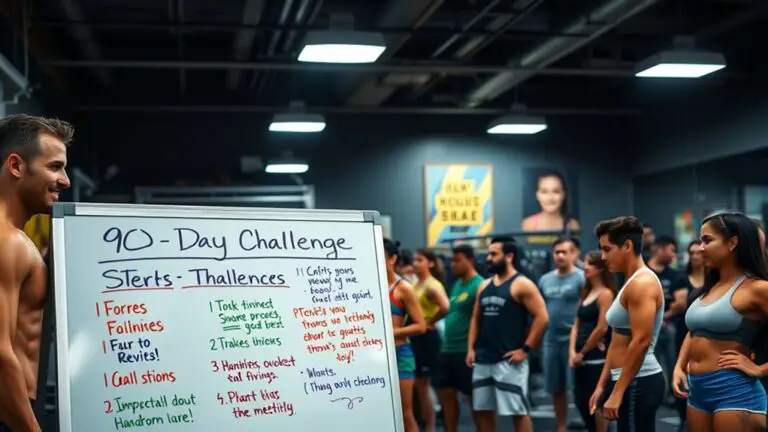The Biggest Gym Training Myths Holding You Back

You’ve probably heard a lot of gym training myths that can really hold you back. Lifting heavy weights doesn’t automatically make you bulky, and you don’t need to spend hours on cardio to lose weight. Avoiding carbs isn’t the answer either, as they’re essential for energy. Spot-reducing fat is a myth, too. Plus, there’s no need for different training methods based on gender. If you’re curious about more misconceptions that could be affecting your fitness journey, continue to explore.
Myth 1: Lifting Heavy Weights Makes You Bulky

Many people believe that lifting heavy weights will inevitably lead to a bulky physique, but this misconception can deter you from reaping the benefits of strength training. In reality, weight training is a powerful tool for achieving muscle definition without adding unwanted mass. If you focus on lifting moderate weights with higher repetitions, you’ll enhance your muscle endurance and tone your body, creating a leaner look.
Additionally, your genetics, diet, and training regimen play essential roles in how your body responds to weight lifting. Women, in particular, often fear bulking up, but their lower testosterone levels make it challenging to gain significant muscle mass. Instead, strength training can boost your metabolism, improve your overall fitness, and help you achieve that sculpted appearance you desire. Incorporating cardio exercises like skipping rope can further enhance your weight loss efforts and contribute to a flatter stomach. So, don’t shy away from the weights; embracing them can lead to a strong, defined physique that complements your hard work in the gym.
Myth 2: You Need to Spend Hours on Cardio to Lose Weight
You might think that spending hours on the treadmill is the only way to shed pounds, but that’s not true. Efficient workouts, including strength training, can be just as effective for weight loss by boosting your metabolism and building muscle. Additionally, incorporating skipping rope into your routine can provide an effective cardio workout that elevates your heart rate and burns calories efficiently. Let’s explore how you can achieve your goals without endless cardio sessions.
Efficient Workouts Matter
While it’s easy to think that spending hours on the treadmill is the key to weight loss, the reality is that efficient workouts can yield better results in less time. By incorporating efficient workout techniques, like high-intensity interval training (HIIT) or circuit training, you can maximize your gym time without feeling drained. These methods not only burn calories effectively but also boost your metabolism post-workout. Remember, the quality of your workout often outweighs the quantity. Instead of endless cardio sessions, focus on shorter, more intense workouts that keep your heart rate up and challenge your muscles. This way, you’ll see better results in less time, making your fitness journey not just effective but also enjoyable.
Strength Training Benefits
The misconception that hours of cardio are essential for weight loss persists, overshadowing the powerful benefits of strength training. In fact, incorporating strength training into your routine not only burns calories but also builds muscle, boosting your metabolism. This leads to more efficient fat loss, even while you’re at rest. Plus, strength training aids in muscle recovery, ensuring you’re ready for your next workout.
| Benefit | Details |
|---|---|
| Muscle Growth | Increases lean muscle mass |
| Metabolic Boost | Enhances calorie burn post-workout |
| Injury Prevention | Strengthens joints and ligaments |
| Improved Endurance | Supports better overall performance |
Don’t underestimate strength training; it’s a vital component of any effective weight loss strategy!
Myth 3: You Should Avoid Carbs for Weight Loss

You might think cutting out carbs is the key to shedding pounds, but that’s a common misconception. Carbohydrates are essential for fueling your workouts and maintaining a balanced diet, which is vital for overall health. Ignoring carbs can actually slow down your metabolism, making weight loss more difficult in the long run.
Carbs Fuel Workouts
Though many people believe that cutting carbs is the key to effective weight loss, this myth can actually hinder your workout performance. Carbs are essential energy sources that fuel your workouts, enabling you to perform at your best. When you consume carbs strategically, or practice carb timing, you can optimize your energy levels and stamina during exercise. Without enough carbohydrates, you might find yourself feeling fatigued, which can lead to subpar workouts and hinder your progress. Instead of avoiding carbs entirely, focus on incorporating the right types and amounts into your diet. By doing so, you’ll not only maintain energy for your workouts but also support your overall fitness goals, making your journey towards weight loss more effective and enjoyable.
Importance of Balanced Diet
A balanced diet plays a significant role in achieving weight loss and overall health, and the idea that cutting out carbs is the best approach can be misleading. Carbohydrates are essential for providing energy, especially during workouts. Instead of eliminating them, focus on balanced nutrition, which includes whole grains, fruits, and vegetables. These foods not only fuel your body but also offer important nutrients. Meal timing is also essential; eating carbs around your workout can enhance performance and recovery. Remember, moderation is key. By incorporating a variety of food groups, you’ll support your weight loss goals while maintaining energy levels and overall well-being. Don’t fall for the myth—embrace a balanced diet that works for you!
Metabolism and Carbohydrates
While many believe that eliminating carbohydrates is the key to weight loss, this notion is fundamentally flawed. Carbs are essential for energy, especially if you’re working out. Instead of cutting carbs completely, focus on carb timing. Consuming carbohydrates around your workouts can enhance your performance and recovery, boosting your metabolic rate. This means you’ll burn more calories even at rest. It’s also important to choose the right types of carbs—opt for whole grains, fruits, and vegetables over refined sugars. By understanding how your body utilizes carbs, you can create a sustainable approach to weight loss without sacrificing energy or nutrition. Remember, balance is key, and carbs can be part of a healthy diet that supports your fitness goals.
Myth 4: You Can Spot-Reduce Fat

Many people believe that by targeting specific areas of their body with exercises, they can reduce fat in those exact spots. This is a common misconception in the world of fitness. Unfortunately, targeted exercise effectiveness doesn’t work the way many hope it will. Fat loss is a systemic process, meaning you can’t dictate where your body loses fat.
Here’s a quick breakdown of fat loss misconceptions:
| Myth | Reality |
|---|---|
| Spot-reducing is effective | Fat loss occurs overall |
| Crunches burn belly fat | Core strength, not fat loss |
| Isolation exercises yield fat loss | Compound movements are key |
Instead of focusing on spot reduction, prioritize a balanced routine with cardio and strength training to promote overall fat loss. Remember, consistency and a healthy diet will lead to the results you want, not isolated exercises. Additionally, incorporating activities like skipping can improve cardiovascular fitness and assist in achieving your weight loss goals.
Myth 5: Women Should Train Differently Than Men
It’s a common belief that women should have a different training regimen than men, but this notion is largely unfounded. While there are some gender differences in body composition and hormonal responses, these don’t necessitate completely different training techniques. Both men and women can benefit from strength training, cardio, and flexibility exercises tailored to their individual goals, not their gender.
Research shows that women can lift heavy weights just like men without the fear of becoming overly muscular. Instead, focus on what works best for you and your fitness aspirations. Whether you’re looking to build strength, improve endurance, or enhance overall fitness, the principles of effective training remain the same. Additionally, incorporating jump rope workouts can provide an excellent cardiovascular workout that benefits everyone.
Don’t let outdated myths dictate your workout. Embrace a training routine that challenges you, regardless of gender. Ultimately, it’s your commitment and effort that matter most in reaching your fitness goals.
Myth 6: Supplements Are Necessary for Success

Despite the widespread belief that supplements are essential for achieving fitness goals, the reality is that a well-balanced diet can provide most of the nutrients your body needs. While some supplements may offer benefits, focusing on whole foods can often yield better results without the risks associated with supplement safety. Plus, there are numerous natural alternatives that can support your fitness journey. Additionally, engaging in exercises like jump rope can contribute to overall muscle toning while helping to burn calories effectively.
| Nutrient | Natural Sources | Supplement Alternatives |
|---|---|---|
| Protein | Chicken, beans, tofu | Protein powders |
| Omega-3 Fatty Acids | Salmon, walnuts | Fish oil capsules |
| Vitamins | Fruits, vegetables | Multivitamins |
Incorporating a variety of nutrient-rich foods into your meals can help you meet your dietary needs more effectively. So, instead of relying solely on supplements, consider embracing these nutritious options for a healthier, more sustainable approach to your fitness goals.
Frequently Asked Questions
How Often Should I Change My Workout Routine?
You should change your workout routine every 4 to 6 weeks to prevent plateaus and maintain motivation. Incorporating routine variation keeps your workouts fresh and engaging, enhancing workout frequency and overall fitness progress.
Is It Better to Work Out in the Morning or Evening?
Whether you choose morning benefits or evening energy, it ultimately depends on your schedule and preference. Morning workouts can boost your day, while evening sessions might help you unwind and relieve stress. Find what works best for you!
What’S the Best Way to Track My Progress?
To track your progress effectively, consider using progress journals or fitness apps. Journals allow for personal reflection, while apps offer data analysis and tracking features, making it easier to visualize your achievements and stay motivated.
Should I Stretch Before or After My Workouts?
Imagine your muscles as a garden. Before workouts, dynamic stretching nurtures growth, while static stretching afterward helps them relax. So, warm up with movement and cool down with stillness to keep your garden thriving!
How Important Is Hydration During Training?
Hydration’s essential during training. It boosts performance, prevents fatigue, and aids recovery. Timing matters too—drink water before, during, and after workouts to maximize hydration benefits. Stay hydrated, and you’ll feel the difference in your workouts!





